The aim of this guide is to help Stores create a list of blog articles that need to get written on a regular basis.
It is hard work to just come up with 1 new article idea each week. Instead, it is much easier if you write down a whole bunch of ideas, schedule them in a task management tool, and assign them out to someone to work on.
This then means that your Store ends up with a regular flow of content, which is VERY important for being found in the search engines.
Step 1: Choose Your Task Management Tool
Stores can use any task management tool that they like, but we prefer to create a separate project in Basecamp and run the editorial schedule through there. It works quite well.
Learn How To Setup Up A Basecamp Account by following the how-to guide.
The same overall structure can be used in any task management tool, even a spreadsheet.
However, ideally you need to be able to:
- Schedule posts month by month, week by week
- Set a due date
- Assign it to someone or ‘anyone’
- Be able to write additional notes and provide links and images
If you would prefer not to use Basecamp then you can search Google for Editorial Schedule Spreadsheet. This is an example of a Blog Posting Schedule created by Aaron Pogue. However a spreadsheet is usually not as useful for communication between multiple people or for inserting images and files.
Step 2: Create Your Structure
In Basecamp:
- Create a To-Do List for each month of the year by clicking “Add a to-do list”. Don’t forget to include the year so you don’t have list repetition after 12 months.
- Order the to-do lists so month follows month. Drag the lists with your mouse to re-order them.
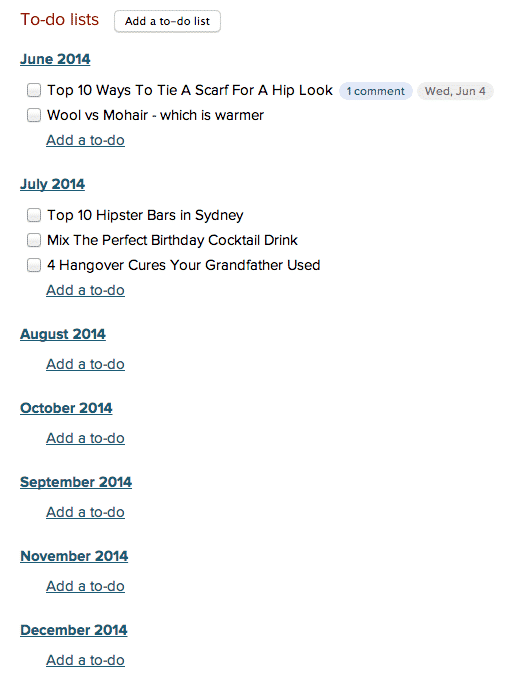
Step 3: Brainstorm Your Headlines
Writing a headline involves actually coming up with the idea for the blog post. This can be a bit like staring at a blank piece of paper. It is a daunting prospect. You need to keep in mind your Blog Content Strategy and combine it with inspiration from the rest of the web.
Idea 1
- The best way to get started is actually with a blank notepad. Sit down and write 100 headlines off the top of your head. Rob Wood is a highly respected blogger and runs lightstalking.com. He said if you struggle to write 100 headlines then your topic is too narrow, or you shouldn’t be writing a blog. Harsh, but quite true.
- Check out The Art Of The Headline how-to guide in the Small Revolution Knowledge Base. There are plenty of titles to get you started. You should copy it into your own Knowledge Base so your writers can also generate ideas without your direct involvement.
- This title generator tool – http://tweakyourbiz.com/tools/title-generator/index.php – can also help spark some ideas. It is a bit spammy looking so you need to be careful to balance those headlines with other types of less sensational variants.
Idea 2
- Look at strong competitors in the same industry and possibly also in related industries. Sign up to their blogs/email newsletters and get inspiration from their ideas. Obviously don’t copy their headlines exactly, or your store will end up being penalised in the search engines for duplicate content.
Idea 3
- You can ask one of your writers to collate a list of popular sale days and then simply insert ideas into the relevant month on your editorial schedule. Holidays, observance or celebrations are useful when you associate them with your Sales Days to add more excitement and theme. You may check on the Annual Sales Dates so you get to offer sales and discounts to your customers.
Idea 4
- Get more ideas by looking through Quora, Yahoo Answers, Reddit and other large communities. Find out what questions people are frequently asking and write articles around the answers.
Step 4: Create The Writing Tasks, In Bulk
If writers are trained thoroughly in what is expected of them then it should be enough to have a quick summary for each blog post.
You will need to ensure that they have read and learned the how-to guides in this Blogging section. (You should copy and paste the instructions from Small Revolution into your own Knowledge Base so they can refer to them constantly.)
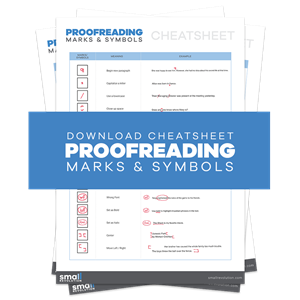
Giving your writers a headline will usually be not quite enough information. (This is why we find spreadsheets too limited for use as Editorial Scheduling Tools – no ability to add extra information).
If you create a few basic ideas your writers can spin further ideas from that starting point, based on the instructions in this how-to guide.
Think about what you would like to receive if you were writing a blog for an eCom store. What makes a useful brief for a writer? For our writers we tend to provide:
- Article Title – We encourage our writers to rewrite the article titles, but always provide something as a starting point.
- Due Date – Schedule your articles so that at least 2 are being published each week. Sometimes your writers will miss a deadline. If this happens, and you are using Basecamp as your task management tool, you can simply drag that task into the next month.
- Activity Code – This is specifically for oDesk freelancers. We use Activity Codes to track the work that employees are doing on particular jobs.
- Memo – Using a memo that is the same as the ticket title helps us track back, often months later, to a task and find out how much it cost the business to produce that article. This is useful for assessing the average cost per article for each writer.
- Process – It is useful to always link to the processes that your writer is expected to follow. Constantly reminding them that there are processes in place will help your writers maintain a high quality output.
- Aim – Keep in mind that your writers are sitting down at their desk, fresh from other pre-occupations and they want to know what it is that they are meant to be doing. Spoon feed them! Providing an ‘aim’ keeps your writers on track.
- Summary – It is useful to provide a quick summary to get your writer started on the right track. Refer back to the how-to guides that they should be following, but also provide a few fresh ideas. This will help them stay on topic for your store.
Here are some examples of writing tasks for different types of stores.
- Example of a ‘top 10 list‘ type article brief for writers
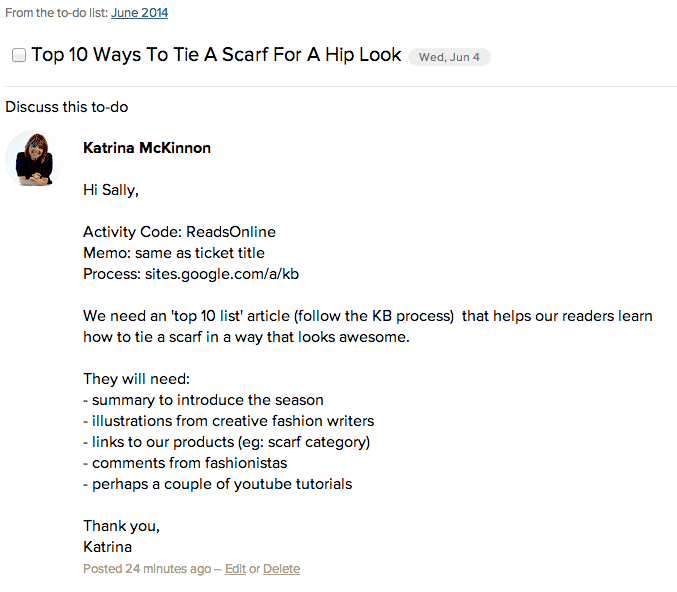
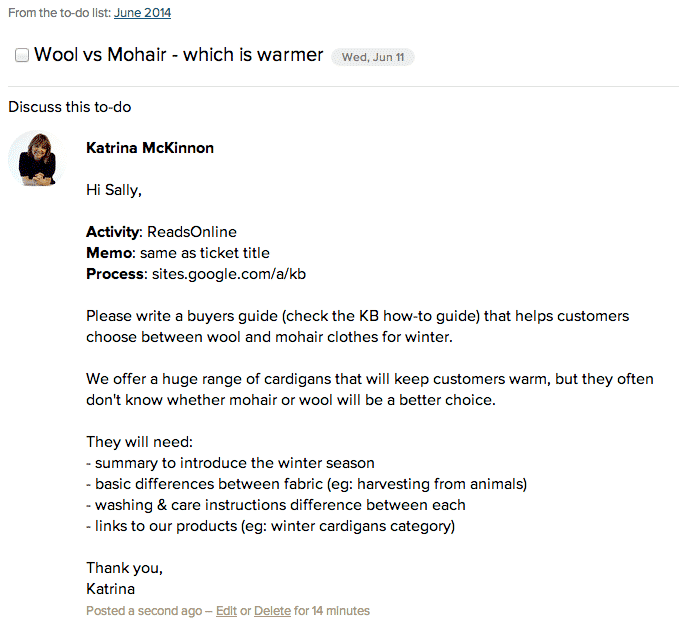
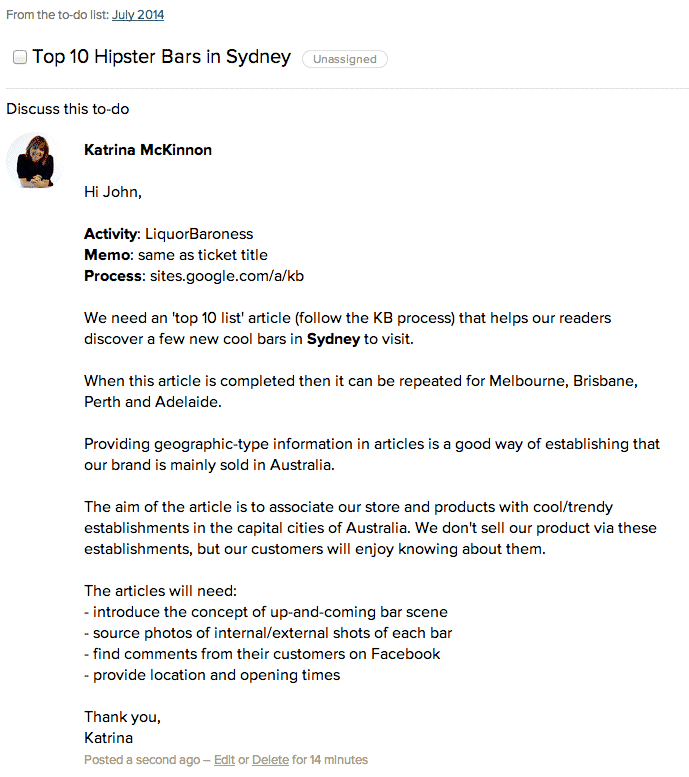
- Example of brief that balances funny and responsible use of the product
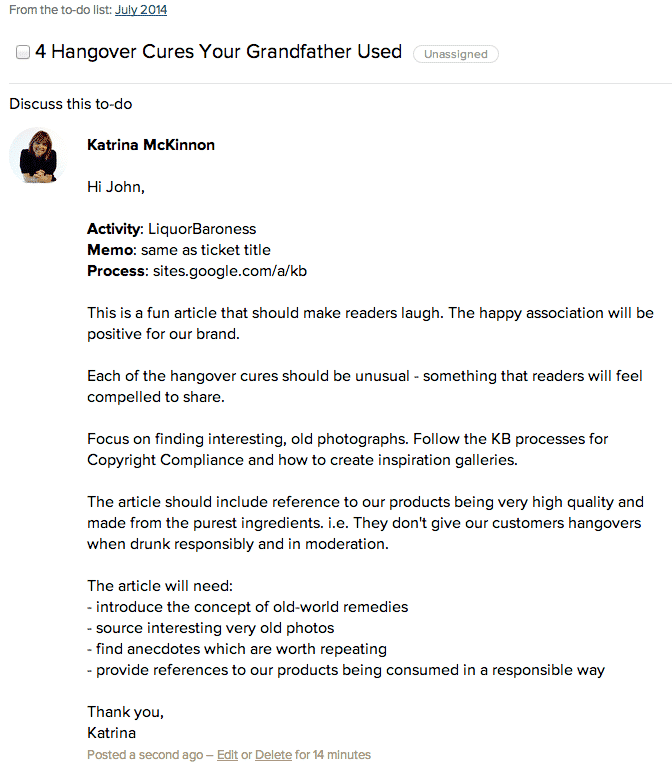
Conclusion
At the end of this guide you should be able to quickly and easily create a bunch of editorial post ideas for your store’s blog. Schedule each task into your task management tool and assign to specific writers – the work should then proceed automagically without your input for another 6 months!
You might also find “Learn how to find a good freelance copywriter” how-to guide useful if you don’t have any writers currently employed.
Photo by yanalya / CC BY

